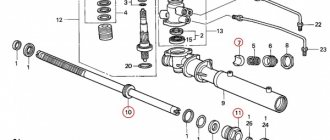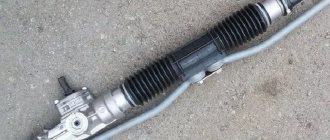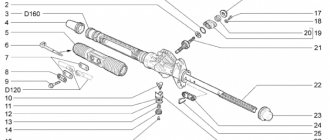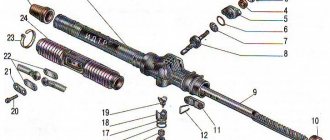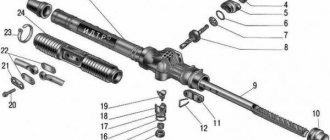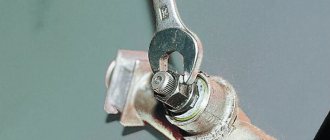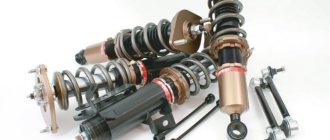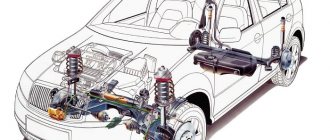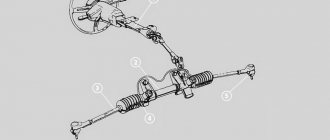The steering is a critical mechanism, any malfunction of which will not allow the driver to continue using the car. Any malfunction must be corrected as soon as possible.
The most popular model of the Russian company AvtoVAZ received rack and pinion steering. Structurally, the mechanism is quite reliable. But at the same time, one of the most common malfunctions is the knocking of the Lada Granta steering rack.
What is a steering rack
The wheel turning mechanism consists of two parts: rack and pinion. Rotating the steering wheel triggers the movement of the gear, which moves the rack left or right. As a result, the wheels turn in the desired direction.
Metal parts of the mechanism can be difficult to turn, which is why modern cars are equipped with amplifiers. There are two types of amplifier - hydraulic and electric. They make turning the steering wheel smooth and easy. The power steering or electric power steering is mounted directly on the rack.
Power steering improves driving safety by dampening vibrations and knocks from the road. The driver feels more confident behind the wheel. On the other hand, this slightly deteriorates the car's handling.
Safety on the road largely depends on the steering. In case of any malfunctions, maneuverability deteriorates, as a result, the driver cannot react to the road situation. Therefore, it is important to maintain the steering in working condition and pay attention to all symptoms of breakdowns.
Power steering and power steering: do-it-yourself installation
The electric booster first appeared on Kalina, then on Grant and on the new Priora. You can drive a car without an ESD. But if a car owner previously owned a car equipped with a hydraulic or electric booster, then, at a minimum, he will experience great inconvenience. On the Lada Granta in the minimum configuration, the manufacturer does not install electric power steering, so many owners of such cars decide to install the power steering themselves. This procedure is not the easiest, and the unit is not cheap. But its presence means a comfortable ride, maneuverability and safety.
Installation does not require any special knowledge or skills; minimal experience and a set of tools are sufficient. If, nevertheless, the question arose about installing electric power steering on the Lada Granta, then when purchasing an electric power steering unit, you should pay attention to its number.
How to determine whether a steering rack is faulty
All steering rack malfunctions can be divided into three types - knocking, humming and leaking. Leakage is typical only for devices with hydraulic booster, since the power steering operates without oil, which means it cannot leak.
There are two types of knocks: superficial and internal. The first ones appear from the tie rod end. Through a torn boot, street dirt gets into the mechanism, the tip fails and begins to knock. You can change it yourself by looking at the steps of the process in the car manual.
An internal knock indicates that the pistons and guide rails have failed. It is very difficult to independently determine the cause, since you need to disassemble the entire mechanism.
Lyrical digression
Suzuki Grand Vitara 2.4 manual, color ZMA Logbook Replacing the steering rack oil seal, without removing the rack. And not only Part-1
In Lada Kalina, the steering rack never makes a knock when we are talking about a new car. This is also true for the break-in period. Let's say in your case this is not done. Then, do not try to repair anything, but go straight to the dealer. According to reviews, the defect in question is covered under warranty, and most car dealers do this: the steering rack assembly is replaced with a new one.
This is what the replacement unit looks like, the rack assembly
There is a logic here. At the factory, adjustments are made correctly (this is true in 99.9% of cases). If a defect appears, the dealer replaces the assembly without expecting that adjustment will solve the problem. The owner does not need to hope for this either. The choice is yours.
Causes of steering rack malfunction
When driving carefully and using the car correctly, the only cause of a steering rack malfunction is its wear and tear.
For each part, the manufacturer sets its own service life; for a rack it is usually 100 thousand km. The timing may vary for each model. Most often, this part is changed by those who drive on bad roads. Getting into a hole wears out the suspension and steering. If you don’t slow down for bumps and potholes, you can become a regular visitor to car services. Also, the rack does not like sudden starts. It is not recommended to drive away suddenly if the wheels are turned to the side.
Another common cause of problems is a boot break. This delicate part protects important mechanisms and therefore requires constant attention. Even cracks on the boot are a reason to replace them. Moisture, dust or dirt that gets inside the device can cause serious damage.
Mechanism repair
Since the steering rack has a complex structure, auto repairmen rarely disassemble it and repair it. It is much easier to buy an assembled spare part and install it on the car.
Today on the market there are original auto parts and cheaper analogues. Car manufacturers recommend installing only original parts, as they fit perfectly into all car systems. But the experience of car enthusiasts says that similar spare parts also last a long time. The main thing is to choose a good manufacturer. This can be done by reading reviews on the Internet or asking advice from an experienced car enthusiast.
Do not forget to periodically change consumables - bushings, oil seals, boots. Periodically inspect the bottom of the car; if there are cracks or leaks, immediately buy a repair kit. This will extend the life of the entire device.
A thrifty and careful driver may not even think about the steering rack throughout the entire period of owning the car. Therefore, it is worth following simple operating rules: avoid potholes, slow down before bumps, and if you have the first symptoms of breakdowns, immediately contact a car service center. Then the device will serve you for a long time.
1200 rub. for the photo report
We pay for photo reports on car repairs. Earnings from 10,000 rubles/month.
Write:
Faults in a car's steering rack can not only cause driving discomfort, but also cause more serious damage and even lead to an accident. Signs of a malfunction are: an increase in mechanical force when turning the steering wheel, the hum of the power steering pump, leaking power steering fluid, knocking while driving on rough roads, rusting of the rack shaft.
Steering wheel tuning on Lada Granta
There are few options for upgrading the steering wheel on the Lada Granta. The most popular of them is installing a sports version. Such a steering wheel will not only make the interior more attractive, but will also increase the comfort of control, especially if it is selected correctly. You can install a multi-steering wheel, but only if the configuration is maximum, in other cases there will be nothing to control with its help.
The sports version must be injury-proof, that is, in the event of an accident it must be deformed without causing damage to the driver. Among the shortcomings, it can be noted that although there is an airbag in the standard steering wheel, the sports one does not have it. You can also modify the steering wheel by installing braid. More advanced ones install a heating thread under it.
To install the sports steering wheel, you will need to carry out the following operations.
- Align the front wheels straight (you can drive a little forward and back so that the trajectory is straight).
- Disconnect the battery terminals by de-energizing the vehicle's on-board network.
- The airbag control module must be disabled (if the Granta equipment is equipped with it). If you do not turn it off when removing the factory steering wheel, it may shoot out.
- Remove the steering wheel and install a horn on the adapter. The wiring must be stored in the adapter; to do this, carefully inspect all contacts.
- Connect the adapter to the shaft, but do not secure it with a nut.
- A sports steering wheel is installed on the adapter and secured with special screws.
You cannot throw away or sell the factory product; the sports version will raise questions when passing inspection.
Signs of a faulty steering rack
Most cars are equipped with hydraulic booster (power steering) or electric power steering (EPS). The main faults of the steering rack are similar in them, but there are also differences, so it makes sense to consider them separately.
Power steering rack malfunctions
Symptoms of a faulty steering rack with power steering are often associated specifically with the hydraulic system - fluid and pump. So, if a hydraulic rack breaks down, the driver will feel:
- Increased effort when turning the steering wheel. In other words, the steering wheel becomes “heavy”, and if you could literally turn it with one finger, now you need to make significant efforts to turn it.
- Regular decrease in power steering fluid level in the expansion tank. This is indicated by a corresponding lamp on the dashboard, fluid leaks under the car or on elements of the engine compartment.
- Knock when driving. It is especially clearly expressed when driving on uneven roads.
- When turning the steering wheel, a strong hum is heard. And the more the steering wheel is turned (no matter in which direction), the louder the noise becomes. Often the hum is accompanied by a slight vibration of the steering wheel.
- After turning the steering wheel, it slowly or does not return to its original position.
- When the car moves straight, the front wheels do not maintain the trajectory, which is why the car “fidgets” along the road.
Electric steering rack malfunctions
In general, electric rack malfunctions are similar to hydraulic rack problems, except for fluid leaks. So, when a rack with an EUR fails, it often happens:
- knocking noise when turning the steering wheel;
- biting the steering wheel;
- uneven force on the steering wheel;
- spontaneous rotation of the steering wheel;
- The red steering wheel icon is lit on the instrument panel.
In general, electric rack malfunctions are similar to hydraulic rack problems, but they are caused by slightly different reasons, which will be discussed below. The main problem in this case is water that gets onto the rod or into the rack control unit.
Causes of steering rack malfunction
There are three main reasons why you may hear a knock in the steering rack. This is wear of the worm pair (distributor), wear of the toothed part of the shaft, wear of the shaft along the bushing.
Thus, the most loaded unit in its design is the clutch between the gear and the gear base. Accordingly, the teeth here may collapse over time - partially or even completely. This can be understood by the knocking sound when holding the steering wheel while driving over uneven surfaces.
If there is no wear on the teeth but slight play on the rod, the situation can be corrected using an adjusting nut. By tightening it, you will establish the optimal distance between the teeth of the rack and pinion. If the teeth are completely broken, then such a rack must be replaced (sometimes only the gear can be replaced).
When a hole has formed in the bushing. Due to corrosion, due to the ingress of moisture, an abrasive appears inside, which eats the bushing (can be plastic or bronze). The malfunction is eliminated by replacement from a special repair kit.
Another cause of failure is wear of the tie rod end or the entire tie rod. This happens due to the rupture of the boot and washout of the lubricant. Usually these parts cannot be repaired, and accordingly, they are replaced with new ones. Same with the ball end.
Non-standard cases
It may not be the suspension or steering parts that are knocking. Shocks and body pecks lead to the movement of units. If they “sit” loosely and there is metal-to-metal contact, clinking cannot be avoided.
- Single dull knock when starting off. See rubber-metal engine or gearbox mounts, transmission driveshaft. For example, when starting, the motor may tilt and hit the spar.
- Rattling on small bumps and in turns. Listen to see if there is a knocking sound in the steering wheel when braking; if there is, the brake caliper guides are worn out.
- Intermittent impact sound, more common when turning at low speeds. Malfunction in the differential of a front-wheel drive vehicle.
Tighten the key bolts and nuts more often, refuel only at gas stations with high-quality gasoline, and remember: a worn CV joint does not knock, but crunches, and does this with the wheels turned out.
Consequences of a faulty steering rack
Drivers are also often interested in the question of what causes a faulty steering rack, and can it be used in this condition? And to understand the consequences, it is enough to know the function of the steering rack.
That is, the first thing that threatens the failure of the rack is impaired control of the car. And if at the initial stage (when the rack just started to creak and/or hum) it still performs its functions, then if it completely fails, the driver may completely lose control of the car!
Quick Guide
The main reason for tapping is the formation of a gap in the joints. In the steering system, there may be knocking on the tips, ball joints of the rods, the rack, the “cardan” in the column, the steering wheel on the shaft, or the auto-folding system in case of an accident. The metallic sound is distinct and can be heard in place when rocking the steering wheel.
It is quite possible to mistake problems in the suspension for problems in the steering, since the initial stages of wear of bearings and supports only make themselves felt when cornering at speed. In the suspension part, the cause of the knock should be sought in the wheel bearings, ball joints and “supports”.
